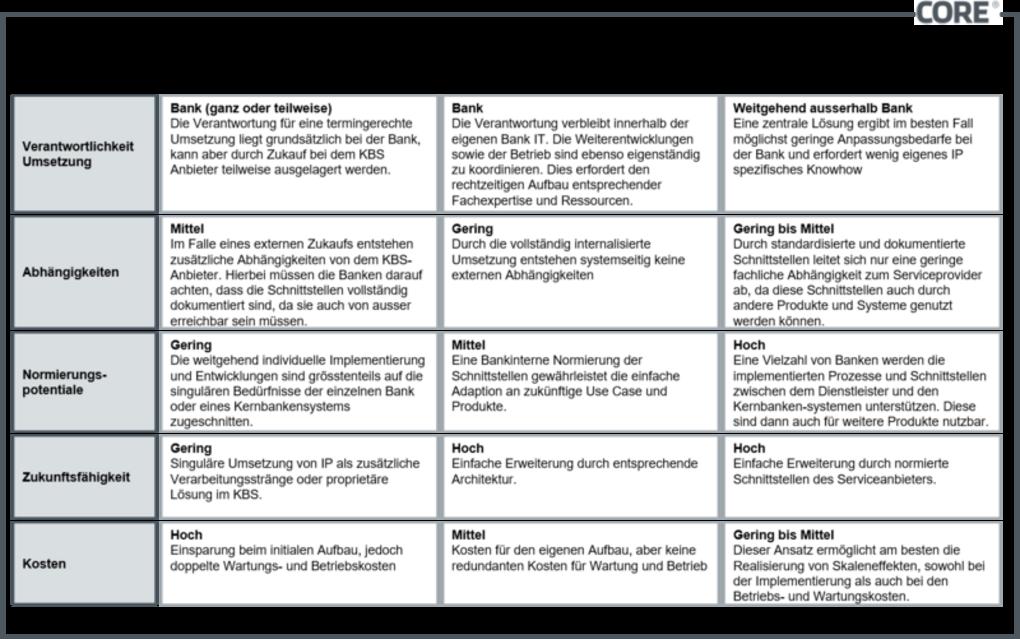Instant payments are also becoming a reality in Switzerland - mandatory from 2024 and 2026 in two phases for incoming customer payments, which must be processed instantaneously via SIC5. A series of articles in three parts sheds light on the developments in fast payments around the clock in general and the central aspects in particular that are of primary importance for banks in Switzerland.
Part 1: Developments in the field of instant payments
Part 2: Challenges in the implementation of instant payments
Part 3: Procedure and solution options, evaluation of the options and conclusion
3. Approach and solution options
As described in the previous chapter, the introduction of IP requires far-reaching adjustments to the IT systems along the entire processing route, which, in addition to the core banking system, also includes other systems such as Risk & compliance systems, connectivity or filing channels. Even if the focus is currently on the introduction of IP, there should be no redundant process routes. And since it is necessary to consider almost the entire payment transaction landscape anyway, the transformation should be designed in such a future-oriented manner that the medium and long-term competitiveness of the institutions is also ensured and the adjustments required by IP at least do not lead to an increase in complexity, but ideally to an improvement of the situation while anticipating future developments.
Accordingly, when considering the solution space, adaptability, modular expandability and maintainability in a modern architecture should be taken into account against the background of a) the current requirements from IP and b) capabilities that will be necessary in the future.
There are basically three solution options for banks that can be used to implement an IP-enabled infrastructure:
The presented solution options in detail:
Option 1: "Single Purpose" development of an IP-enabled infrastructure
In the context of this option, the banks decide to use a "minimal" solution that only covers the short-term regulatory and resulting technical IP rollout requirements supported. This is a dedicated infrastructure that usually leads to the construction of a separate route and promises a low-investment IP-enabled infrastructure.

In principle, the necessary capabilities can be built up within the scope of this option by the bank itself or through offers on the market, for example by purchasing from a core banking provider. In the case of an independent implementation, the bank also builds this solution "on top" of the existing system landscape, which, however, implies the build-up of technical debt at the bank in the long term. Alternatively, these components can be purchased via an IP module on the market. Here, too, these components are installed "on the side" and thus parallel to the existing infrastructure.
Duplicate effort for maintenance and operation are the result in both cases. In the latter case, it also increases the dependency on the core banking system provider, which is already noticeable today, and this supposedly inexpensive option often turns out to be a fallacy - especially if the adjustments that will be necessary in the future are taken into account.
Another danger of this solution is that due to a proprietary implementation and close linking of the processes to the KBS, this option cannot be expanded (or is not very flexible) and therefore cannot be used for other payment types or use cases based on IP.
Option 2: Setting up an expandable and future-proof IP infrastructure
With this option, the banks decide to set up an IP-enabled infrastructure individually. In addition to meeting the short-term regulatory goals, this should also offer expandability and be future-proof. This presupposes that the institutions not only have to implement the relevant processes along the payment transaction chain in accordance with the SIC rules, but also align the entire payment transaction infrastructure in advance and consistently with future requirements.
Specifically, when developing the solution, it should be ensured that an IP-enabled infrastructure is implemented through minimal intervention in the existing system landscape, but in no case leads to the build-up of additional technical debt. This can be realized by building the process control on existing interfaces and not integrating it specifically with IP. If this is not directly possible, these interfaces should be further developed in terms of standardization so that all payment types can be integrated.
Otherwise (in addition to the initial effort to be made anyway) there will be effort for the other payment channels, which in turn will lead to expenses for redundant maintenance in the event of future adjustments. The payment processing systems should therefore be flexible and modularly expandable, so that future use cases can be integrated through standardization of the interfaces via standards and do not lead to double processing routes.
In this respect, in addition to quality goals for IP, the adaptability to future products and the integration of other, future submission channels (such as schemes) and maintainability must be taken into account when evaluating the solution.
The responsibility for timely and complete IP capability, including the requirement for connectivity to SIC5, lies entirely with the respective bank, which must also allocate the full investment costs to its own business. In addition, this option requires the provision or the development of the necessary expertise and competencies in-house.
Option 3: Outsourcing payment transactions to an external service provider
The last option presented follows an outsourcing approach. Here, the banks decide to outsource the payment transactions to a service provider that takes over the entire process control and only calls up dedicated functions via standardized interfaces at the bank. The service provider implements the connectivity to the SIC5 Clearing & Settlement Mechanism (CSM) and also checks compliance with the relevant process requirements.
Time-critical services such as Risk Scoring and Compliance Screening Services (RCS) or bank checks can also be outsourced, so that banks can largely focus on reserving and posting payments. However, the exact cut between the services to be outsourced and those to be provided yourself must be made consciously and requires a well-founded analysis, otherwise the disadvantages of option 1 also threaten. The need for adjustment at the banks is limited - with a smartly chosen system interface - to the implementation of the interfaces for calling up the individual services and real-time bookings in the core banking system, including the corresponding availability of the systems.
With the central approach, responsibility for implementation is partially shifted to a central authority, while responsibility for cost risks is shifted completely to a central authority. This approach can make sense both for smaller banks that do not have the appropriate expertise or budget for their own integration, but also for larger banks that have not defined payment transactions as part of their product portfolio that differentiates them from the customer. However, such an initiative requires a willingness to reach consensus on the part of the participants involved.
4. Evaluation of the solution options
Various aspects play a role in the evaluation of the proposed solution approaches. First of all, as part of the project initiation, it must be defined who is responsible for the analysis, initial implementation, further development and operation of the respective components. Smaller banks in particular should not underestimate the need to ensure the appropriate expertise for such an implementation project.
Attention should also be paid to the implementation speed. Depending on the initial situation, dependency on peripheral systems can lead to fundamental architectural changes at the bank. The costs (investment costs as well as operating and maintenance expenses) must also be considered at this point.











How to get the perfect look for Cos...
Test winner at Stiftung Warentest:...
Cream for Rosacea: The Best Creams
Dry elbows: This is how brittle ski...